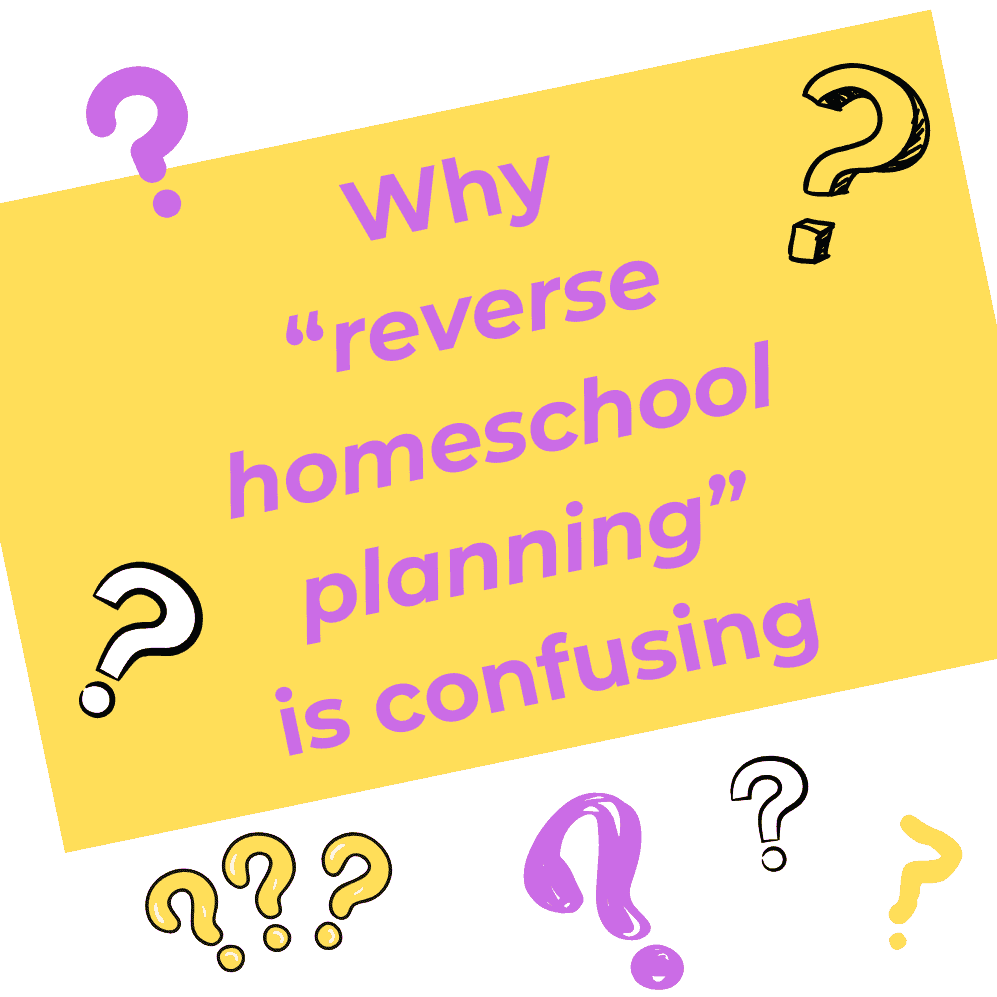There’s a new-ish homeschool planning term that seems to be making its rounds lately. And for many it brings such freedom. But for others it brings confusion. Reverse homeschool planning is a way homeschoolers are tracking and organizing their homeschool days without all the mess of making detailed plans in advance.
But is that really what it is?
Let’s take a deeper look.

What is reverse homeschool planning?
Reverse homeschool planning is a term that is used to describe a system that involves doing little planning in advance, but simply writing down what you do each day in your homeschool. You choose a curriculum that either has plans laid out already or only requires you to do the next lesson each day. Then you just look back on your day (I think this is where the reverse comes in) and write what you did that day.
It’s a very simple strategy for organizing things, staying on task, and tracking things so you can create records easily at the end of the year.
On this site, I actually teach this practice by calling it tracking. You know all those habit trackers? That’s basically what you’re doing. Tracking that you did the things.
But if you reverse plan something, it actually usually means something entirely different! Let’s consider this more.
What is reverse planning in general?
Reverse planning in general is a way to plan your project (or homeschool) by thinking about your end goals. Make steps throughout your year to accomplish those goals. You will set goals to finish, and divide the work into easy steps to accomplish throughout your year or project.
If you were applying this concept to your homeschool, you might set a goal of finishing a math book by the end of the year, then decide how many pages needs to be done each day in order to accomplish that goal. Then work each day to complete that many pages in the math book. Simple.
Yall, this is exactly how I teach homeschool planning. Reverse planning is planning using goals. I mean, honestly, how can you make any plans really without having an end goal? It’s a strategy to plan your year.

Why it’s confusing
You may think I’m splitting hairs here, but when a new term is adopted in one small section of the world and it has a completely different meaning than it does in the rest of the world, it’s confusing! If you google reverse planning, it gives tips for planning your project with end goals in mind. If you google reverse homeschool planning, it tells you to write down what you do each day and that’s it! Those are two very different meanings!
Many may not find this confusing, but I think it isn’t helpful when trying to teach others organizational systems. Then if they are trying to find out more about something, it’s hard to find the information if we are not all using the same terms to describe it. It just causes confusion.
Why has this term come to mean what it does in the homeschool world?
While I don’t know for sure, I’ll be honest and say that I wonder if the person or people who coined the term feel some sort of shame or obligation in the way homeschoolers “should” plan. They want to be a person who plans and feel good about that and “fit in”. But they just aren’t that person.
I am here to say that’s okay you are not that person! Planning doesn’t have to be complicated and tracking can be most of what you do in your homeschool organization! It’s a great organization tool!
Maybe they were under the impression that planning your homeschool has to be complicated and difficult. That is has to require a ton of hours and effort. While I’ll be honest and say that it can require a lot, it doesn’t have to! Every homeschool parent is different and every family is different. Simple is good!
Can we just let go of all the “should” in homeschooling? There is not one way to do this thing! We are all unique and different and bring different things to the world of homeschooling.

Just say what it is
I am one who thinks words and definitions matter. Instead of trying to coin some fancy word for something that already exists, let’s just call it what it is. Planning and tracking. Maybe I’m too logical like that, but if we aren’t on the same page with the word, then how can we make sure we are discussing the same thing? Why make things even more confusing?
If you want to call something reverse planning, then be sure what you are doing is actually reverse planning. It’s frustrating to others if you change it.
If you want to come up with a fancy word for how you organize your homeschool, then I’m on board! But just be sure it’s not already a term in use, and if it is, be sure you are sticking to the established definition of that term. Otherwise, it’s just confusing!
Be yourself
Sometimes it seems that there are competing groups in homeschooling, just like in the Mommy Wars in general. The Unschoolers, the Charlotte Mason Homeschoolers, the Classical Homeschoolers, the Planners, the List-Makers, the Ones-Who-Don’t-Write-Anything-Down, The Non-Planners, The DIY-ers, The Fly-By-the-Seat-of-My Pants-ers. I could go on. And each group thumbs its nose at every other group.
Can we all just decide that it’s okay to be yourself? Let’s take the things we have been given and use them to the best of our abilities. There is not one right way to homeschool. There isn’t one right way to organize your homeschool.
Those who need a list, a curriculum and a plan will teach their kids well with those tools. Those who can make things up as they go will also teach their kids well without those tools.
We’re all just doing our best here.
Ultimately, we need to decide that we are all in this together. Don’t try to make yourself seem like you’re a planner when you’re not. It’s really okay to not want or need detailed plans. And don’t belittle others who are planners by using words that confuse organization systems. Just call it what it is and keep moving on.

Don’t make it complicated
There’s a misconception in the homeschool world that in order to be a “good little homeschool mom” you have to plan your homeschool by writing down in advance what you will do each day. In detail. In a planner. But for most, that only leads to messy planners, wasted time, and lots of guilt! I understand why no one wants to do that!
Not only is that extremely frustrating, but it is overcomplicating something that doesn’t have to be difficult.
And that’s why I created this site. Because planning your homeschool shouldn’t make you feel like you’re stuck and tied down to your plans. It shouldn’t make you feel guilty to decide to do something different today than what you planned two weeks ago!
There is a better way. And the truth is, we can still be good homeschool moms and make simple plans without all the complicated mess and guilt!
How to come up with a basic homeschool plan
To create a very basic homeschool plan for your year, all you need to do is come up with a general idea of these things:
- The days you will likely do school
- The resources you will use
- Amount of each resource or topic you want to accomplish each day
That’s really the basics of a plan.
If you want to also list out these lessons for each day, go for it. But instead of writing it into your planner each day, put it into list form without any dates. Then each day you do school, you’ll do the next thing on the list. No crossing things out or changing days. No writing and re-writing.
Read: How to create a homeschool plan that works for you.
The key to any homeschool plan, though, is to keep it flexible! And this is why I suggest not using dates in advance or writing anything in your planner before it’s actually done – that’s not flexible. Here are some other thoughts on keeping your homeschool flexible.

How to truly plan in reverse
Planning in reverse is how I teach homeschool planning on this site. Choose topics and resources based off of needs and goals for your children. When planning out the resources you chose to accomplish those goals, break each resource down into achievable chunks for each month/week/day. Then as you go through your school year, work each day to do the planned amounts for each day so you can achieve your end goals!
For more on my approach to homeschool planning with goals in mind, check out this post: How to create a homeschool plan that works for you.
Tracking your homeschool
If you have the basics of plan nailed down with the days you will do school, the resources you will use, and how much of each resource to do each day, then tracking is straightforward! You can then just write down what you do each day after you have done it, just like others suggest in the misnamed reverse homeschool planning method.
Or if you took the time in advance to make a list of your daily lessons as I described above, then all you need to do to track your day is check off the things you accomplished. You don’t even need to re-write it if you don’t want to.
For most, showing a record of what you did each day is not required, so actual dates don’t matter as much as the completion and mental progress. But if you want to show dates without re-writing the lesson names, you can write the date at the top of the page as your child completes them.

Rid the confusion
It’s likely that the term reverse homeschool planning wasn’t purposely confused. The one who coined the term was likely just looking for a way to get out of the mess that many planning systems bring. But those systems are not the only way! Let’s not further the confusion by continuing to use the term in your homeschool organization efforts. Let’s instead plan or track or both! You can even plan in reverse! But let’s keep definitions straight by using the right words for the right systems.










